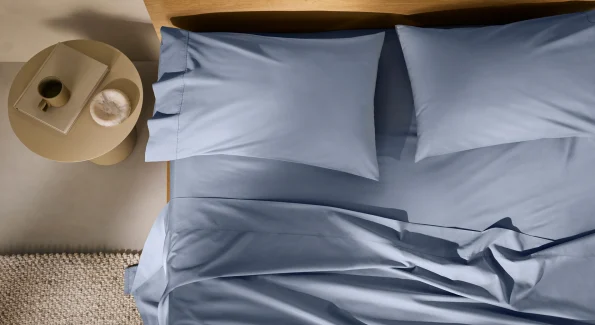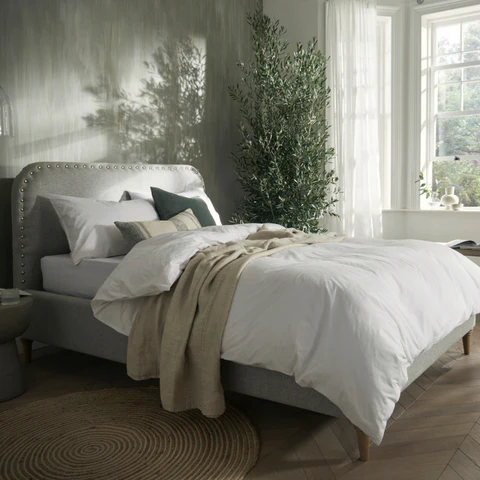Selecting the Perfect Summer Bed Sheets
Summer, for all its joys—think picnics, festive meals with friends, and those blissfully long and lazy days spent at the beach where lightweight loungewear is perfectly acceptable as daywear (or even workwear)—also brings its unique downsides. We’ve all experienced the relentless insects and the intense need for aloe vera after a bit too much sun. But perhaps the most challenging aspect is the inability to get a good night’s sleep when evening temperatures are utterly sweltering. While we invest in the best bedding to keep you cool in summer, what truly makes or breaks an ideal summer bed is what’s right against your skin: the summer bed sheets. Choosing these isn’t just about the obvious ones like material; there’s a surprising amount of criteria to take into consideration, from thread count and weave to even colour. Trust me, after countless personal experiments, getting these details right can transform your sleep experience.
When I’m faced with a hot summer night, my first thought always goes to finding the best summer sheets. It’s about creating a personal oasis. While some might suggest turning off the aircon (though, let’s be real, I usually keep the fan on and have ice packs in the freezer ready for extreme heat), the real magic happens with the sheets themselves. The goal is to find those that truly help you stay cool, making your bed a haven rather than a heat trap. Navigating how to choose summer sheets involves a holistic look at these elements to ensure you’re not just comfortable, but genuinely refreshed. It’s a journey I’ve embarked on many times, and the payoff of a cool night’s sleep is immeasurable.

Unveiling the Best Materials for Summer Slumber
When it comes to answering “What’s the Best Material for Summer Sheets?” we’re diving deep into the very material that touches your skin. We often hear about a product being “breathable,” and this breathability is key: it refers to how heat and moisture are drawn, wicked, or allowed to escape from your body. As someone who’s spent countless nights trying to find that perfect balance, I’ve learned that the right fabric can make all the difference. Cotton, a true staple, derived from natural sources like the seedpod of the cotton plant, has been cultivated for 7,000 years for a good reason. As Australian cotton enthusiasts will tell you, it “loves moisture,” effectively wicking it away and allowing it to evaporate. This is a godsend when you’re humid and sleeping sweaty; it keeps you cool and dry while you sleep, ensuring heat won’t trap and instead heats escaping. My personal experience confirms that on those heating up nights in Australia, cotton truly shines.Beyond cotton, another champion emerges, especially as you see it pop up in droves across Instagram and TikTok: linen. This lightweight summer fabric, crafted from natural fibres of the flax plant, boasts an OG fibre that’s remarkably hollow, allowing with ease for both air and water circulation. My translation? When you’re asking “what type of sheet is best for cooling,” linen is a resounding answer – it’s very cool and incredibly absorbent, a true boasts of wicking nature for sweaty sleepers. You might notice a “running thread” (and yes, that’s a pun intended) here: the best material for summer sheets seem to be ones that come from nature. This brings us to TENCEL™ Lyocell, a fantastic “plant-derived party” addition. Its raw material derives from wood pulp, sourced from sustainably managed forests. This cellulosic fibre is soft to touch, breathable, manages moisture (yours!), and supports the regulation of your body temperature, making it a great one year-round. You can even combine TENCEL™ Lyocell fibres with other aforementioned fibres like cotton and linen. It’s like adding chocolate to a recipe – adding TENCEL™ Lyocell to a blend makes everything better; the fibre ends up enhancing the functionality of its partner, as well as the aesthetic. Just look at ranges like Byren or TENCEL™ Lyocell & cotton sheeting ranges. Furthermore, an important consideration for sustainability is “Are Bed Sheet Recyclable” which impacts the lifecycle of these materials.

Deciphering the Ideal Thread Count for Summer Comfort
The term “Thread count” is one that’s often bandied about, for better or for worse. However, as I’ve previously spoken about, this concept is frequently woefully misunderstood. There’s a common belief that higher is always better, but frankly, that isn’t true. Think of thread count as a measurement tool that simply measures sheet weight. It’s the number of threads lengthwise added together with the widthwise threads. Specifically, it represents the total number of threads woven per 10 square cm (10cm x 10cm). So, if you see a sheet with a 400 thread count, it means there are 400 threads woven together in a 10 x 10cm space. A 1200 thread count, on the other hand, means 1200 plyed threads in that same square. The higher the count, the more threads, and the weightier the sheet becomes. From my own experience, heavier sheets often lead to a less refreshing sleep in summer, regardless of how “luxurious” they might feel.Ultimately, personal preference plays a significant role. Some individuals might enjoy a luxurious, heavier-weight feeling, akin to a hotel bed, while others crave the lightest of touches. For those particularly hotter nights, however, the best thread count for summer sheeting definitely leans towards the lighter end of the scale, specifically the 300 and 400 thread counts. This range allows for air to pass through the weave, actively helping you stay cool while sleeping. It’s about optimizing breathability, not just density. And while a Printed Bed Sheet might catch your eye, its thread count, and the weave it’s built upon, will be the true determinants of your summer comfort.
Understanding the Weave for Optimal Summer Comfort
When considering “What’s the Best Weave for Summer Sheets?”, it’s not just semantics; unlike “old mate Shakespeare” suggesting a rose by any “other name” would “feel just as “good,” the “different weaves” and their “names” are incredibly “relevant.” They “contribute a lot” to “what type of sheet” ends up being “best for cooling”—take that, “Romeo and Juliet”! Getting “back to weaves,” it’s essentially “how two separate strands” of “yarn interlace”—specifically, how the “horizontal strand” (the “weft”) “goes over” or “under” the “vertical yarn” (the “warp”) and “vice versa.” While there are “many different types,” for “summer bed sheets,” I’ve found a “percale weave” is “generally recommended across the board.” This is a simple “one-over-one-under” “compact weave” that offers a “more matte finish” “compared to its counterparts.” Crucially, this weave “allows air to breathe” through the “interlacing threads,” “making for a cool, crisp, lightweight finish” that truly makes a difference on warm nights.

